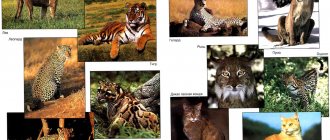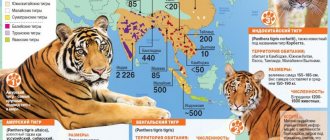In mathematics, everything is simple - minus times minus gives plus. The same rule applies when saving species from extinction. It just takes a lot of time to turn all the minuses into pluses. In the case of the Amur tigers, this took 78 years, during which their numbers went from tens to hundreds.
The Amur tiger remains the master of the taiga
How did the species become endangered?
Let's look at the reasons that almost led to the death of the species.
Uncontrolled shooting
Uncontrolled poaching has affected the species' numbers more than other factors. The animals were killed for their skins, bones and other derivatives, which are still highly prized in Asian markets. There have been cases where tigers were shot to prevent them from attacking domestic or farm animals or competing with human hunters.
The first restrictions on hunting appeared in 1947, the ban on trapping was introduced only in 1956. From that moment on, a slow recovery of the population began.
About 95% of the entire Amur tiger population now lives in the Russian Federation
Habitat loss and change
Amur tigers live in the forests of Sikhote-Alin, without these forests a tiger cannot survive. Unlike other cats, tigers are solitary animals. In nature, each adult animal is assigned its own domain: for females, its area can reach 500 km²; for males – 800 km² and more. Due to large-scale deforestation, the number of tiger habitats and the quality of these areas have seriously decreased. The number of animals that form the basis of the predator’s diet - roe deer, wild boar, wapiti and others - has decreased. In search of food, tigers began to visit places uncharacteristic for them more often, including near human habitation.
Capturing tiger cubs
The capture of young animals for zoos, circuses and animal export continued until 1956. Over several years, 41 individuals were caught in the Primorsky Territory. This was a serious blow for an endangered species: Amur tigers have a relatively weak ability to reproduce, they breed only once every two years, and a litter usually contains 1–2 cubs.
Habitats
Today, the Amur tiger is relatively rare. The Red Book contains it in its list. Its distribution area is concentrated in the southeast of Russia in a state-protected zone. These, as noted above, are the banks of the Ussuri and Amur, belonging to the Khabarovsk and Primorsky territories.
They are more common in the foothills of the Sikhote-Alin ridge of the Primorsky Territory (Lazovsky district), where every sixth wild Amur tiger lives in a not very large area (according to statistics for 2003). Today there are some plans to resettle animals in Yakutia (the territory of the Pleistocene Park).
How to increase tiger numbers?
Preserving and increasing the number of rare animal species is a big and very difficult job. It requires the combined efforts of government agencies and public organizations. WWF became involved in the conservation of the Amur tiger and its habitats in 1994. It all started with the creation of a network of anti-poaching teams, because at that time poaching was one of the main threats to the tiger.
Later, the foundation became involved in preserving forests for tigers; these activities include fighting fires, creating protected areas, and developing proposals for changing legislation. WWF participated in monitoring and recording the tiger; thanks to the fund’s specialists, a state strategy for the conservation of this species was created. WWF initiated work with customs authorities and the Ministry of Internal Affairs. The fund's employees also interact with game users, on whom the fate of the planet's rare predator depends.
Work is also carried out at the international level. For four years now, WWF has been supporting joint competitions between Chinese and Russian rangers in tiger and leopard habitats. The challenge cup for the winner of the regional competition of state inspectors of federal protected areas of the Trans-Baikal Territory “Best in Profession” remained in the Sokhondinsky Nature Reserve.
Tiger Population Status Assessment
To understand what happens to a tiger in the wild, there are several research methods. To estimate the number, a state one-time census is used, which is carried out once every ten years. Many specialists take part in the work: they cover a certain route in a short time and record all traces of the tigers’ vital activity. Analysis of this information allows us to determine the number of tigers throughout their habitat in the Russian Far East. In addition to this method, there is a state monitoring system that allows you to track changes in the status of tiger groups at 18 sites in the Primorsky and Khabarovsk territories. This work is carried out annually. There is also a program for population assessment and monitoring in almost all federal protected areas and some hunting areas. All this allows us to understand what measures are necessary to preserve the species.
Video “Pathfinder's Primer” /media/video/nasha-rabota/bukvar-sledopyta/
Conflicts with a person
Conflicts between predators and humans have always arisen. Work to minimize them allows you to save the lives of both people and animals. Possible reasons: lack of food for the tiger in its natural habitat, its illnesses, injuries, as well as human negligence towards their own property, for example, free grazing of farm animals and much more. In 95% of cases, conflict is provoked by a person.
To resolve these situations, with the support of WWF, special groups were created in 2012 to minimize conflicts with large cats. They respond to all reports of detected predators and go to the call, where they scare away or catch the tiger on the spot.
If a captured animal needs medical attention, it is first placed in quarantine and then in a special rehabilitation enclosure. Experts then decide whether to return the tiger to the wild. If there are no obstacles, the animal is released into its natural habitat. So over the past 10 years, 23 tigers have returned to their native forests.
In 2012, special groups were created to minimize conflicts with large cats
Working with hunting farms
Almost 80% of tigers live in hunting areas in the Russian Far East, and WWF works directly with some of them. The Foundation has created a network of model hunting farms based on the principles of strengthening the environmental objectives of existing protected areas. Almost all of the network’s farms are located on the perimeters of nature reserves, national parks or sanctuaries, and their total area is almost 10% of the tiger’s habitat. They are focused on working on sustainable environmental management and finding a compromise between hunting and the conservation of rare species. They protect wild animals and feed them in times of famine. The number of tigers in these farms is steadily growing, which proves the effectiveness of such work.
Map of model farms where Amur tigers live
Fight against poaching
Since 1994, WWF has supported the work of government agencies to combat poaching. It includes federal and regional protected areas, the state hunting control service and other specially authorized bodies.
The Foundation sends equipment, equipment, fuel for specialists, conducts seminars, provides legal support and conducts forensic examinations. The network of anti-poaching teams created together with partners has significantly reduced poaching of tigers and ungulates. Over the past 25 years, 46,322 protocols have been drawn up - and this is a stack of paper 90 meters high; 8,332 guns were seized - and this is 3 disarmed motorized rifle regiments; 907 criminal cases were opened; More than 100 skins and bones of more than 50 tigers were seized; 514 forensic examinations were carried out; 2,452 cases of detention of harvested wildlife objects were recorded, of which 773 cases involved species from CITES (Convention on International Trade in Endangered Species of Wild Fauna and Flora).
Description
This is the largest predator on the planet and is one of the rare species of animals. The weight of an adult tiger is 300 kilograms. There is some information about existing males weighing about 390 kg, but today there are no such large individuals in nature. Body length ranges from 160 to 290 centimeters, tail length – 110 centimeters.
The Ussuri tiger is a decoration of the taiga of the Far East and an object of worship for many peoples of this territory. Possessing powerful physical strength, the animal is capable of dragging a horse carcass along the ground for 500 meters, and can also reach speeds in the snow of up to 80 kilometers per hour, second only to the cheetah in this.
This subspecies of tigers is the only one that has a 5-centimeter layer of fat on its belly, protecting it from cold winds and very low temperatures. The tiger's flexible body is elongated, its legs are short, its tail is long, its head is rounded with very short ears.
It is known that the tiger can distinguish colors. At night, he sees much better than a person. The fur of this subspecies of tigers is thicker than that of their relatives living in warm regions, and the color is lighter. The color in winter is orange, with a white belly.
Reaction to humans and pets
The tiger of the Primorsky Territory, compared to other subspecies, is distinguished by its peacefulness towards humans. Usually a predator that notices a person moves away from him and tries to avoid a direct meeting. Even conflict tigers, who live for a long time near populated areas and regularly visit them in order to kill domestic animals, as a rule, avoid people. Meetings between a person and the owner of the taiga occur infrequently, but if they happen, then only in rare cases does the predator show aggression. Nevertheless, potential danger exists, and in some cases the Ussuri tiger can attack a person. A survey of individuals that attacked humans showed that 57% of them were injured by a person, 14% had wounds of unknown origin and 21% were sick or emaciated.
An animal may show aggression when being chased, unexpectedly confronted, or defending its prey or offspring. The death of a person from a tiger attack is extremely rare: over the past 40 years, 16 cases of fatal attacks by predators on humans have been recorded in Russia. From 2001 to 2010 19 cases of attacks on humans were registered, as a result of which 12 people were injured and 2 people died. However, most of the attacks were provoked by humans.
The most common type of conflict is the “striped” attack on domestic animals. Such situations account for 57% of the total number of registered conflicts. On average, about 30 cases of death of domestic animals from attacks by tigers are recorded annually in Russia, most of the dead animals are dogs, about 5 cases are cattle, which is an order of magnitude less than in other countries where the predator is common.
Hunger is not a big deal
After all, it is hunger, according to Sergei Aramilev, that forces animals to come out to people.
— Each of the 550 tigers that live in the Far East needs to catch and eat about 50 adult ungulates per year, and in total this is almost 30 thousand deer, roe deer, and wild boars! And if it is impossible to obtain such an amount of meat on his hunting area, we get a guaranteed “repeat offender.”
Such striped hunters were spotted in May in the villages of Chelny and Malyshevo, Khabarovsk region. They carried out explanatory work with the heads of settlement administrations and advised them to remove dogs from the streets and give up free grazing of livestock. Pets can become easy prey for hungry animals.
Last year alone, in our region, according to data, 32 so-called “conflict situations” were recorded, that is, when an animal comes out to people. The striped ones visited populated areas, carried away dogs and livestock. To relieve tension among villagers, environmentalists have developed a program to compensate for damage caused by the Amur tiger. In 2022, nine insurance claims were registered, and victims were compensated for eight steers, three cows, two deer and one horse.
And now, in six months, 51 conflict situations involving wild animals, including tigers, have occurred in the region. This data is provided by the Ministry of Natural Resources of the region.
How many Amur tigers are left in the world?
Today, according to information from the World Wildlife Fund, the number of Ussuri tigers is more than 500.
The dynamics of changes in the number of this subspecies of tigers, starting from the very beginning of the 21st century, appears as follows. As of 2005, the number of predators in the south of the Far East was approximately 423-502 individuals (adults - 334-417, babies - 97-112). In the spring of 2013, this value was 450, and according to 2015 data – 523-540 individuals. It should be noted that this is not a lot and not a little. This is exactly how many predators can be accommodated in the areas of the taiga that have not been deforested today.
The hand of Moscow - towards the tiger
So, in June 2008, the World Bank, the Global Environment Facility and the Smithsonian Institution, along with partners, launched an initiative: to join the efforts of tiger range countries (TRCs) to save the tiger from... people. And already in April 2009 in Thailand, at the international meeting “Forgotten Crisis”, representatives of 21 countries called in the adopted manifesto to strengthen the fight against crimes against wildlife and, in particular, against the illegal trade in wild animals and their parts (derivatives). That same year, at the Global Meeting to Save the Tiger in Kathmandu, specific recommendations were developed and adopted. Listing them, Amirkhan Magomedovich, as an active participant in these processes, especially emphasizes the following decisions:
— stop construction projects in key tiger breeding areas;
— prohibit financial institutions from financing such projects if they have an adverse impact on the state of the most vulnerable tiger habitats.
And even go for “voluntary relocation of people using incentives, generous compensation, to ensure the integrity of key, most vulnerable tiger habitats.”
— Is our signature under this document? — I ask Amirkhanov.
- Eat. And not only under this. Russia itself offers promising projects. Take at least.
- Well, how about the execution?
He answers reservedly:
- Everything is fine.
— And if specifically, in numbers?
— We have committed to restore the Russian tiger family to 500 animals by 2022. In 2022, the census showed that more than 500 wild cats live in the Amur taiga.
- Can we say that the beast has been dealt with?
— Yes, work went along all lines.
- Now if only we could deal with forest poachers just as effectively...
Too long absence
The disappearance of the male, who received the nickname “Monster” for his size, was reported by Aleksey Gotvansky, a specialist in monitoring specially protected natural areas of the Khabarovsk Territory of the Federal State Budgetary Institution “Zapovednoye Priamurye” .
Alexey recently completed another expedition to the Anyui National Park, during which he took readings from numerous camera traps, with the help of which the life and movements of tigers in the wild are monitored.
Based on the results of the analysis of the materials, the specialist discovered that there was no footage of the Beast. By the winter of 2020-2021, the tiger was spotted at all line traps along its routes, but by the spring of this year, the number of shots with it had halved. To date, the tiger has not been spotted for 9 months.
“I am a biologist. I don’t harbor vain hopes - the tiger, having been gone for so long, will not return. Most likely, he died, or from old age, maybe,” Alexey Gotvansky told Vesti-Primorye.
Under guard. How to protect a tiger Read more
Reasons for disappearance
Of course, the main reason that the number of Amur tigers has dropped to almost nothing is their moderate extermination by poachers. Up to a hundred tigers were killed a year just to get their skin.
However, scientists who studied this issue in detail found that the reason for the disappearance is not only mass shooting. The reasons for the disappearance could also be the following:
- critically insufficient amount of food items;
- deliberate destruction of bushes and trees where Amur tigers lived.
It goes without saying that these two factors did not arise without human help.
Russia is a country of tigers. Only India has more predators than us
Currently, experts are preparing for the next big census of Amur tigers. In the mid-1990s, their population was estimated at 415-470 individuals, in 2005 - at 420-500 individuals, in 2015 up to 540 tigers were counted, and according to monitoring data in 2019, the total number of individuals increased to 580.
According to scientists, for those territories now occupied by predators, these figures are close to the maximum. Next, the tigers will have to move to those lands where the species once existed, but then disappeared.
In November 2022, he reported that traces of a young male were found at the mouth of the Bollokhtokh River, the right tributary of the Uchur River. General Director Sergei Aramilev commented on this event as follows: “When we hear the word Yakutia, we imagine the Laptev Sea and the city of Tiksi, although in reality a significant part of the Khabarovsk Territory is located much further north than the southern part of Yakutia, where the wandering tiger entered. Most likely, he has already returned to the Khabarovsk Territory... What pushed the tiger to the north? The phenomenon that allows animals to expand their range is similar to the mechanism of dispersal in humans. It was vividly described by the scientist Lev Gumilev . He asked to imagine the entire population of a particular region as a burning “bonfire” from which “sparks” fly off, which, as we know, mostly go out, but some, once on a fertile “substrate,” form a new bonfire. Tiger-wanderers are precisely those “sparks”. Let us wish the tiger to return back “home”, because in the places where he wandered, he will not be able to light a new “fire”.
According to the International Union for Conservation of Nature (IUCN) in 2016, there were about 3,900 tigers on the planet. Russia ranks second in terms of tiger population, second only to India, where over 2,300 predators live. It is interesting that in both Russia and India, the population of the largest and most powerful representatives of the cat family is steadily growing thanks to government programs for the conservation of predators.
Reproduction
Tiger “weddings” are not strictly timed to a specific time of year - they can be observed in any month, but still more often at the end of winter. After 3.5 months, in the most remote, impassable place, a solitary tigress gives birth to cubs. Usually there are 2-3 of them, sometimes 1 or 4 and very rarely 5. They are very helpless, weigh no more than 1 kilogram, but develop and grow quickly. At the age of two weeks they begin to see and hear; at the age of a month, the cubs are twice as heavy, they become nimble and inquisitive, climb out of the den and even try to climb trees. They begin to eat meat at the age of two months, but mother's milk is sucked until six months. At this age, the cubs reach the size of a large dog and switch entirely to meat food - from now on until the end of their days.
The mother first brings them fresh food, then leads them from one prey to another. Two-year-old tiger cubs weigh up to one hundred kilograms and begin to hunt under the guidance of their mother. She patiently and thoroughly conveys all her experience to her offspring. The tigress solves all difficult problems alone; the male does not take any part in raising his children, although he often lives next to them. A tiger family breaks up when the young animals turn 2.5-3 years old.
Tigers grow throughout their lives, so by old age they reach their largest size. They have no enemies. Only a very large brown bear can overcome it. In the Ussuri taiga, massacres of these two giants are not uncommon. The winners are in some cases bears, but more often tigers; Both rarely leave the scene of a bloody meeting alive; they fight to the death. The loser is eaten.
Security
The fate of the Amur tiger is dramatic. In the middle of the 19th century it was numerous. At the end of the 19th century. Up to 100 animals were hunted annually. In the thirties of the last century, wild cats were occasionally found only in the most remote corners of the Ussuri taiga, difficult to reach by humans. The Ussuri tiger is on the verge of extinction due to unregulated shooting of adult individuals, intensive hunting of tiger cubs, clearing of forests in the vicinity of some rivers and a decrease in the number of wild artiodactyl animals caused by increased hunting pressure and other reasons; Winters with little snow also had an adverse effect. In 1935, a large and one-of-a-kind Sikhote-Alin State Nature Reserve was organized in the Primorsky Territory. Somewhat later - Lazovsky and Ussuriysky nature reserves. Since 1947, tiger hunting was strictly prohibited. Even the capture of tiger cubs for zoos was allowed only on occasion, with special permits. These measures turned out to be timely. Already in 1957, the population size almost doubled compared to the thirties, and by the early sixties it exceeded a hundred. The Ussuri tiger was listed in the Red Book of Russia as an animal that was on the verge of extinction. But in 2007, experts working for the World Wildlife Fund announced that this species is no longer endangered: the animal population has reached its highest level in the last hundred years.
Best articles: Baleen whales: classification, description, nutrition, behavior and threatsThe Ussuri tiger is protected by the state - it is listed in the Red Book of the Russian Federation; hunting and catching the mammal is prohibited. Since 1998, the federal target program “Conservation of the Amur Tiger”, approved by the Government of the Russian Federation, has been implemented.
Social structure and reproduction
Photo: Amur tiger cub
Individuals of Ussuri tigers lead an isolated lifestyle. Males rarely join the pack. The habitat of individual individuals practically does not overlap. Due to its polygamous nature, a male can exist in one territory with several females at once. He enters into marital relations in turn with each representative of the opposite sex. Offspring appear most often once a year, three to four months after entering into mating relations. There are known cases of breeding offspring twice a year.
Females never abandon their young. Caring for the offspring falls entirely on the shoulders of the mother. The female obtains food for both herself and the cubs. She protects the kids, teaches them to hunt and lead an isolated lifestyle. If another male claims to enter into mating relations with one of the females, a severe attack cannot be avoided. Males fiercely defend their right and primacy to enter into mating relations. During the breeding season, females typically produce certain sounds with which they attract individuals of the opposite sex. Males rarely make any sounds during the mating season.
Puberty occurs upon reaching 4-5 years of age. Females also tend to mark their territory during the mating season. A week after the start of estrus, the female is ready for mating. Often tigresses themselves go in search of suitable partners. Often a sign that females are in search of a partner are marks on tree trunks.
On the ninth day after birth, the babies' eyes open. After two weeks, teeth begin to appear. Despite the fact that the mother begins to feed the kittens meat from the age of two months, they continue to feed on mother’s milk for up to six months. Independent hunting is possible no earlier than from the age of one. An adult is considered an individual that has reached 3-4 years of age.
We live together
Our world, together with the atmosphere, hydrosphere and biosphere, is a living natural complex. It should not be full of holes, or with holes, or lopsided, cross-armed or lame; neither overeat to the point of belching, nor sink to the point of famine, nor die off on the vine. If this happens, it means that someone in our world still does not understand: the Universe, the Creator, which created this world in the most secluded corner of the Milky Way, provided everything, absolutely everything for our survival and development: it happened so. What happened to our world?
We sneer in vain, revealing our ignorance, when scientists tell us about this: they say, we live once again. According to the laws of those creative forces of the Universe, everything lives on our Earth: these forces are wiser and stronger, so much more superior that they are able to control the worlds, destroy them and recreate them again. This principle of omnipotence is also manifested on our planet. He controls our brain and the possibilities of our cognition for our benefit, giving a signal: do not encroach on the prerogatives of the Creator.
Are we deaf or what? Or we are so stupid that we hope: tomorrow we will eat and drink, sleep and lie down, roll up our sleeves and... There will always be a tomorrow for the Universe, but for some in the Universe it will not exist. Just like on Earth.
Scientists are increasingly asking the question: how much virgin territory is needed for the Earth’s fauna? Similar to how we consider the territory of pastures for grazing livestock. After all, in the taiga, mountains, and jungles, everyone who has the right to survive from God must have their own territory under their control. Axiom. Like the tiger, leopard, snow leopard, sable, beaver, bear, stork and starling... Our Earth is doomed by God to cohabitation, otherwise there will not be enough territory to implement the principle of “each creature in pairs.”
In these notes we tried to debunk the persistent legend: everything in time disappears without a trace. Our history affirms: yes, unbelief disappears, but the rebirth created by people gains immortality.
Philippa and Vladik
The tiger story, which is now being “written” in the Far East, is interesting and instructive for young and old. Here is one of its first pages.
...Residents of the village of Filippovka, Primorsky Territory, were awakened by the loud barking of a dog. It turned out that the commotion was caused by a big cat, rummaging around the backyard. We took a closer look: it was a tiger cub, hungry and defenseless, who came out to people... The five-month-old helpless tiger cub, it seems, was deprived of its mother by poachers. The baby was caught, fed and transported to the Primorsky Territory Animal Rehabilitation Center. The name Philippa stuck to her - that’s what the residents of Filippovka called her.
A year and a half later, in April 2017, the mature tigress Philippa, agile, well-fed and strong, went into the taiga to the Dichun reserve. A similar story happened with the tiger cub Vladik.
But for Philippa and Vladik there is an important task for specialists and scientists: they were “restrained” with collars with a GPS module in order to obtain new information about the life of tigers. The first information from Vladik baffled everyone: he went in a circle for hundreds of kilometers. It looks like it's to mark its domain. Aw man!
How it eats and who it hunts
A nutritious diet for an Amur cat should include daily consumption of at least 9 kg of meat. Therefore, hunting is a major part of her life. Nature has endowed the beast with great strength, well-developed sense of smell and hearing. Over short distances, it is capable of running at speeds of up to 50-70 km per hour.
The objects of hunting are wild boar, deer, wapiti, roe deer and elk. But if he remains without food for a long time, the predator will not disdain small prey: hares, birds, rodents, fish. Its diet may include berries and various plants.
A cunning and insidious animal creeps up to the object of the hunt quietly and unnoticed, and then with a lightning-fast jump overwhelms the victim, trying to break its cervical vertebrae with its fangs. The attempt does not always end in success. Observations showed that tigers killed other animals outright only one time out of ten.
The animal butchers the buried prey while lying down, holding the carcass with its strong paws. He hides the leftovers from competitors.
This is truly the king of beasts. Its prey can be not only large wild boars and deer, but also huge bears (up to 450 kg) and moose (up to 600 kg). In confrontations with bears and large wild boars, only decrepit old individuals or small females can suffer defeat. In any community of wild animals, the tiger dominates, although in fights with a bear or boar it does not always emerge victorious.
Links of one chain
Scientists, environmental experts and game managers agree that food supply is the main problem for tigers today. And the preservation of forest plantations, especially oak, is of great importance for cats. Currently, the remaining oak plantations are being massively cut down.
“If these green areas are lost as the basis of the ecological chain “oak - wild ungulates - Amur tiger,” the consequences for the Russian tiger population could be most catastrophic,” explained Sergei Aramilev. “Deprived of food, he is forced to go to people, and such situations are not always resolved in favor of the animal.
Often after such meetings with a person, the animal ends up in a rehabilitation center. But this is in the best case, and in the worst case it dies. Fortunately, those who managed to get out have every chance of being released again. Next, experts monitor the striped animals using GPS collars, which, at the request of Rosprirodnadzor, are worn on all predators released into the wild.
Once a quarter, a “field” check of data from devices is carried out. The batteries on the gadget last for two to three years, after which the fate of the tiger can only be known if the animal gets caught in a camera trap. They are installed throughout the habitat of the Red Book species. Based on the data obtained, experts agree that their adaptation in the wild is successful in most cases.
Thus, the tigress from Lazo and the tiger cub Saikhan were rescued at the end of 2016 and the beginning of 2017, respectively. The “girl” herself went out to people in search of food, since she had lost her mother and could not hunt on her own. And Saikhan was found in the forest with a gunshot wound to the head in very serious condition. Specialists performed several complex operations and were able to restore the tiger cub’s facial part of the skull and the visual function of the eye. In May last year they were released into the wild in the Jewish Autonomous Region.
Courts handed down five convictions in 2022 in cases related to crimes against the Amur tiger.
Despite their affection for each other, the animals, once free, went in different directions. The tigress immediately headed southwest and occupied a territory covering the southern part of tigress Philippa's territory. Saikhan initially stayed close to the release site, but then headed southeast, crossed the border and ended up in China. He did not stay there and soon returned to Russia. Over the past few months, Saikhan and his unfortunate partner have been living in the same area, but keeping a distance that varies from 30 to 50 km. Experts do not rule out that they will soon meet again and, perhaps, form a married couple.
- Far Eastern turtle: how schoolchildren raised Red Book reptiles for Lake Gussi - material at the link.











